
The Salon du Tapis d'Orient is a moderated discussion group in the manner of the 19th century salon devoted to oriental rugs and textiles and all aspects of their appreciation. Please include your full name and e-mail address in your posting.
by R. John Howe
The last of the presentations in the recent Textile Museum Rug Convention (October 12-14, 2001) was given by James Blackmon (The James Blackmon Gallery, San Francisco, California).
In this photo essay, we are going to present most of the pieces that Mr. Blackmon showed in the order in
which he treated them. I am drawing for my text here on notes graciously taken by Richard Isaacson, who curated
the TM exhibition "From the Amu Darya to the Potomac: Central Asian Bags From Area Collections," which
was the related exhibition, open during the Convention. I have also supplemented Jim Blackmon's comments occasionally
with reference to some related published material.
Although he provided an estimated attribution of each piece, Mr. Blackmon very carefully indicated that he was
not too concerned with addressing who actually made what, since there is much confusion in the literature about
geographic attribution. Instead he was mainly interested in his presentation to speak about aesthetics and rarity.
Regardless of the ultimate character of the associated text (and although Messrs. Blackmon and Isaacson have seen
it, they are absolved from any responsibility for it, since I've have put it together myself), I can assure you
that there is some remarkable material in this presentation.
Mr. Blackmon described Image 1, the piece hanging in front of him on the podium, as a bedding bag face with side
panels woven in one piece.

Jim owned this piece 27years ago and bought it in Afghanistan. This weaving was labeled by M. Eiland 25 years
ago as Kara Khirgiz from the Pamir. George O'Bannon said that it was Kazakh (in, Kazakh And Uzbek Rugs From
Afghanistan, 1979). The piece is single wefted. It is woven with warp direction as longest dimension on a narrow
beam loom.
The second rug was a julkyr.
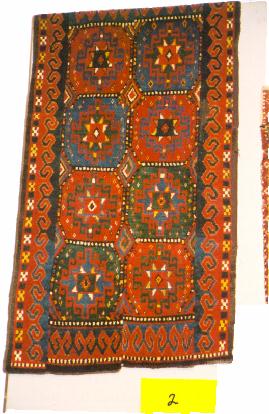
These "bearskin" rugs are Uzbek, with very long pile and often made of strips sewn together. This one, with compartmented Memling guls, is made from four strips, two broader and two narrower. The structure is warp predominant plain weave, also sometimes called "warp-faced back," and is related to the weave used in mixed technique pile and plain weave Turkmen tentbands.
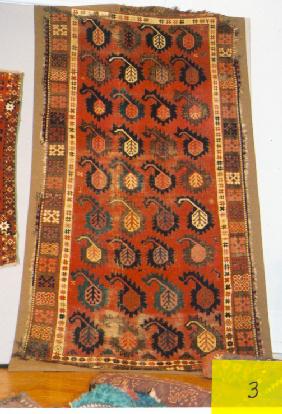
The third rug was a Kyrgyz piece, 4' X 9,' with a field of botehs. It has classic single-wefted structure
and was woven in the Fergana Valley in the southern part of Kyrgyzstan.
Rug 4 was very colorful, with two rows of large major Turkmen-like guls that have internal zoographic-seeming instrumentation
that resembles tauka naska renditions.
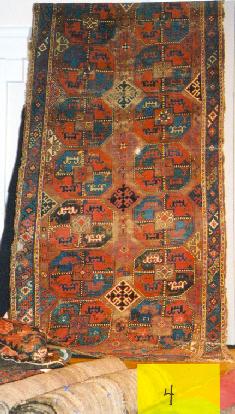
This rug is now seen to have been made by Turkmen Uzbeks. Thirty years ago such rugs were called "Karakalpak,"
following Bogolyubov. They have depressed warps and can often be as stiff as Bijars. Most of them seem less likely
to have been woven by tribal weavers, since their large size and stiff handle make them less easy to transport.
But this piece is very supple and thin despite the depressed warp. It could be an early tribal piece and, Blackmon
feels, definitely predates the group of stiff Bijar-like pieces from the late 19th century. He estimated this rug
to be mid-19th century or before.
Rugs 5 and 6 are similar.


They are Karakalpak weavings, single-wefted and contain silk, cotton and insect dyes.
Jim Blackmon described Rug 7 as an ikat-inspired design, woven by Kungrat Kyrgyrz weavers. In The Kyrgyz Carpet
I, Antipina calls this format a chavadan. Blackmon cites the labeling of the Kungrat group as an example
of the confusion in the literature. O'Bannon calls them a Kyrgyz tribe while other writers call them Uzbeks or
Lakai.
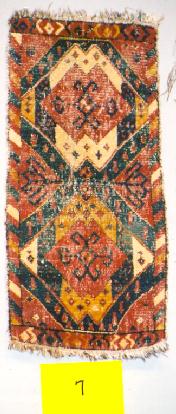
They are long, narrow storage sacks with an opening on a narrow end and were used to store various household items (harnesses, women's jewelry and personal items). But they were apparently meant to be displayed sideways as part of the family juk. The juk was a place in either the tent or a recessed area in a house where the families "wealth" in textiles was displayed.
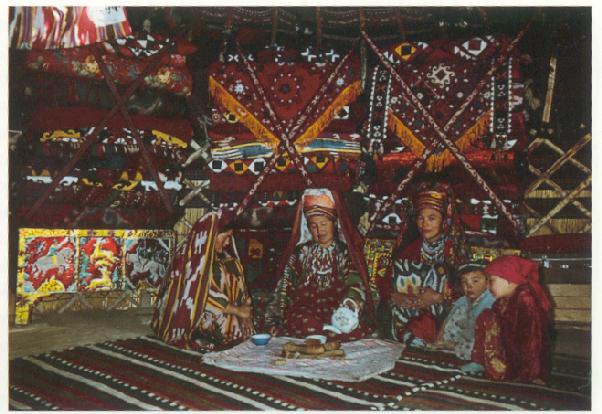
The chavadan was always placed on the bottom, long-side horizontal with the pile side out and visible
at the bottom facing edge of the pile and apparently hanging somewhat below it. Remember this comment when we examine
the very last rug in Jim Blackmon's presentation. Blackmon said that Rug 7 is single-wefted.
The eighth rug has a similar format.
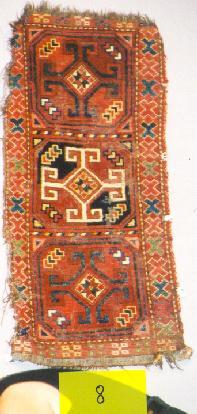
Rug 8 has a compartmented design with good color and a cruciform device in each compartment. It is also single-wefted, but is described as Uzbek.